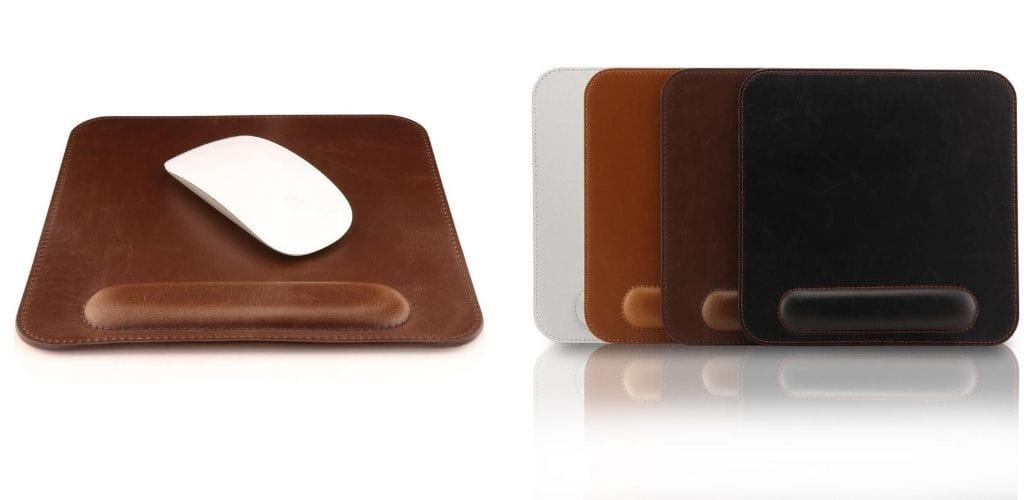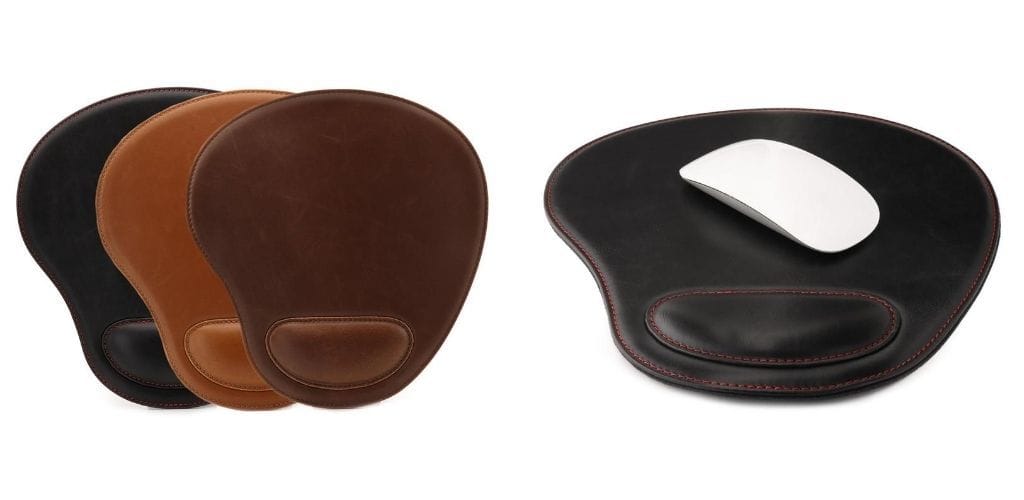A mouse pad is a surface for moving a computer mouse. It has a surface that is optimized for idea control of your mouse. It is designed to increase the usability of the mouse, especially compared to using the mouse directly on a table or desk. Choosing the right mouse pad can make a difference in how you navigate your computer.
MOUSE PAD COLLECTION
MegaGear offers a selection of superbly designed and crafted mousepads that are stylish yet practical. Each type provides all the desirable qualities of a modern mouse pad, such as non-slip backing, ergonomic support and exceptional tracking efficiency due to their smooth surfaces. Our variety of options, including full-grain vegetable-tanned cowhide or PU leather, padded wrist rests and a selection of different shapes, sizes and colors, ensures you will find the perfect one for your needs and tastes. With the ability to be customized or personalized, our mouse pads also make great gifts.
All of our mouse pads offer the following features:
- Crafted from high-quality full-grain vegetable-tanned or PU leather, accented by fine and durable stitching
- Sleek look and slim body
- Artisanal craftsmanship with a high aesthetic appeal
- Non-slip backing, ergonomic support and exceptional tracking
- Silky-smooth surface for the efficient and uninterrupted use of your mouse
- Practical size, reducing desk clutter
Personalized Fine Italian Leather Mousepad with Padded Wrist Rest
Available in Green, Damson, Black, Brown
PU Leather Mousepad with Padded Wrist Rest
Available in Dark Brown, Light Brown, White, Black
PU Leather Oval Mousepad with Padded Wrist Rest
Available in Dark Brown, Light Brown, Black
Personalized Fine Leather Extended, Large Mousepad for Desk
Available in Black, Brown, Damson
Personalized PU Leather Extended, Large Mousepad
Available in Black, Dark Brown, Light Brown
The History of the Mousepad
The mouse pad wouldn’t exist without the computer mouse. The mouse was first invented in the 1960’s by Douglas C. Engelbart, a World War II veteran and a researcher at the Stanford Research Institute. His first prototype was made from wood and fitted with two metal wheels. He called it a “mouse” because, according to Engelbart, “the tail came out of the end.” It did not gain worldwide recognition until the introduction of Apple’s Mackintosh twenty years later. It paved the way for the emergence of the mouse pad.
The first time anyone saw either a mouse or mouse pad was in 1968, at a demonstration by Engelbart in San Francisco entitled “the Mother of All Demos.” It was called a “mouse tray” and was in fact a control console that included a keyboard, with an inset portion used as a support for the mouse, which had wheels as a control mechanism. It was designed by Jack Kelley, who worked with Engelbart at Herman Miller, the iconic furniture manufacturer. A year later, Kelley designed a simple mouse pad to support Engelbart’s invention.
When the Apple computer was introduced in the 1980’s, a company called Mousetrak, founded by Bob McDermand, was credited with producing the first mouse pad. McDermand, a one-time aviation instructor with ties to Silicon Valley, was friends with Steve Wozniak, a fellow pilot, and Steve Jobs. He quickly discovered that the mousing experience varied, depending on the surface on which it was used. He experimented with wood, glass, sheets of paper, finally realizing he needed something he could carry with him for a consistent surface. The iconic version was a rounded rectangle made from polyester on rubber, creating a perfect surface for a tracking device. The poly made it possible to transfer designs onto its surface, so soon he began to mass produce mouse pads featuring the Apple logos as well as designs for Disney, Paramount and LucasFilm. Because he never patented his work, it was not long before countries all over the world began to create similar items.
Around the same time, Armando Fernandez, a worker at Xerox, created a rubber pad to use with a mouse that would not slide off a desk. It was created specifically for use with the Xerox mouse, which used a roller ball, a design which was used for decades. These earlier mouse models relied on mouse pads for movement because they increased the friction of the ball at the bottom of the mouse as well as protected it from dirt from dirt. The mouse pad also helped preserve the mouse’s control mechanism. But because Xerox charged so much for its version of the mouse pad, it was neither accessible or affordable. Fernandez never got the credit he deserved.
The term “mouse pad” was first used in 1983 in an article in InfoWorld, a tech publication. The British referred to it as a “mousemat.” Many different styles and designs have emerged over the years, as well as different components and materials. Today you will find round and square, small and large mouse pads; hard and soft mousepads; ergonomic mouse pads including those with wrist rests; gaming, light-up and charging mousepads; mousepads customized with a logo or design; and mouse pads made from all types of materials including aluminum, glass, rubber, plastic and leather.
Why Use a Mousepad
There are many reasons to use a mouse pad:
- Speed
- Precision
- Comfort
- Wrist protection
- Protection of desk or table surface
- Reduction of debris collection under the mouse
- Lack of jitter
- Aesthetics and style
- Protection of mouse
- Desk mats
Types of Mouse Pads
There are many types of mouse pads to fit different mouse technologies and uses:
Gaming: Gaming mouse pads provide a smooth and consistent surface, which is usually hard. They are typically larger than regular mouse pads to provide room for more movement. They are often made from aluminum, glass, plastic or carbon fiber. They are pad for desk designed for endurance and extended use.
Optical Mice: Earlier types of optical mice, which use image sensors to detect movement, tended not to work well on reflective surfaces such as polished wood or glass. Nowadays, mouse pads for use with optical mice have precision surfaces that eliminate spot jitters.
Padded Wrist: Mouse pads with padded wrist supports are designed to increase ergonomics, specifically to reduce pressure on the carpal tendons. The padded support ensures that the wrist remains parallel to the table surface.
Textured: Textured mouse pads, originally made from vinyl, are very popular. Modern mouse pads are often made with fabric, which provides a lint-free surface for the mouse to move on. Mouse pads can be made from plastic, wood, rubber, steel, rubber, leather, and synthetic leather.
Wireless: Newer generation mouse pads incorporate a wireless charging system, so there is no need to replace or recharge batteries.
Hard versus Soft: This distinction is important to gamers. Soft mouse pads are typically made from cloth and fabric. As a result, they provide more friction when the mouse is moved. The mouse is easier to control and will stop on a dime. Hard mouse pads have a rubber backing and smooth plastic surface that is easy to clean. Their flat texture results in less friction- impeding movements, so it is easier to move the mouse around. A hard mouse is often preferred for its greater precision for quick moves. It is also easier to clean.
How to Care for Your Mousepad
It is important to clean your mouse pad regularly. If it is not cleaned, cursor accuracy may start to deteriorate. Most mouse pads can be cleaned with a damp towel. You should not use commercial cleaning products, since they might harm the finish. Check with the manufacturer of your mouse pad for any specific recommendations.
For leather mouse pads, do not spot clean. Wipe the entire surface down regularly with a dry cloth. Use a damp cloth for dirt and grime. If your mouse pad becomes stained, you may need to use a cleaner made specifically for leather. It may also need to be conditioned from time to time with a leather conditioner.
Mousepad Material: Genuine vs. PU Leather
Leather is a great choice for mouse pad material because it has smooth surface, and is durable, long-lasting and timelessly beautiful. Vegetable-tanned leather is the leather of choice for mouse pads because it is thick and rigid. PU leather, artificial leather that is not animal-based, provides another wonderful option because of its uniform even texture, resistance to water and sunlight, and its less expensive price tag.
What is the difference between genuine leather and PU leather?
Genuine leather comes from an animal, typically cow, sheep or goat. Because it is an organic material, it has a tendency to decompose or putrefy. A process known as tanning is used to preserve the leather. Leather is coveted for its natural look, great feel and even for its “leathery” aroma. It is also remarkably durable and difficult to puncture or tear. PU leather, on the other hand, is synthetic. It is made from polyurethane, a form of plastic.
Leather is the material of choice for a wide range of products because it is extraordinarily durable, looks great and becomes more beautiful with age. PU leather is artificial leather, made without the use of animals to mimic real leather. It is produced by applying a coating of plastic polyurethane to a base made of fiber, usually polyester. It has a texture similar to animal skin, but it is lighter in weight and generally not as durable as genuine leather. The advantage is that it is less expensive than leather, resistant to sunlight, and is considered to be vegan. In addition, it can be manufactured in a wider range of colors than leather and is easier to clean. But unlike leather, it maintains a uniform appearance throughout its life and lacks “personality.”
What is the Difference Between Vegetable-Tanned Leather and Other Leathers?
Vegetable tanning is the ancient process of preserving leather. The hides are soaked in a solution of tree tannins consisting of leaves and bark mixed with water. Over a long period of time, normally up to two months, the leather absorbs the tanning solution, thereby becoming preserved for life. It is an old-fashioned, artisanal process, often done by hand, and free of the use of harsh chemicals. The result is a stiffer leather, which makes it ideal for personal accessories such as mouse pads. It is also beautiful and natural, with a lovely leathery scent.
The use of chromium salts, also referred to as chromium tannage, is a modern-day alternative to vegetable tanning. It is a much quicker process in which the hides are tumbled in a vat with the tanning solution for as little as 24 hours. Chromium tanned leather is lighter in weight and more supple, making it an excellent choice for upholstery and garments.
How Can You Tell the Difference between Genuine and PU Leather?
Here are a few pointers:
- Smell: Leather smells distinctly leathery, while PU leather may have a plastic or chemical odor.
- Aesthetics: Leather has natural imperfections while PU leather will look consistent throughout, with a patterned look.
- Water: Water will bead up and roll off PU leather. If you spill a few drops on vegetable-tanned leather, it will be absorbed and may create a dark spot, which should eventually dry and disappear.
The Bottom Line
While some fear the mouse pad will be rendered obsolete by the optical mouse, people around the world are deeply attached to their mouse pad. Mouse pads can make a personal statement, serve as an accessory to make a desk space more stylish, increase performance, enhance comfort and make gaming more enjoyable. As long as there are computers and mice, there will be mouse pads or desktop pad.









